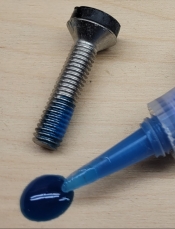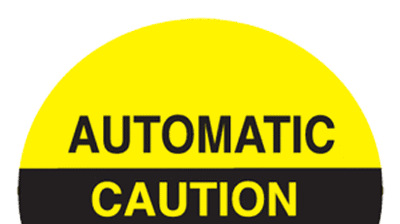THREAD LOCKING AGENTS
Why no heavy door hardware
should be installed without it
By Michael Panish
Door Expert Witness & Consultant
Download PDF of this article here
Thread lock is a chemical product that was originally developed by an American sealant company in the early 1950’s. Patents for this type of product are found as early as 1960.
The goal of every competent professional door installer and door service provider is to perform their duties in an efficient and cost-effective manner. Solving issues on an immediate basis, with no need for repeated costly call backs makes the most financial sense for all parties. A professional door contractor must recognize and understand every possibility for product failure, component detachment and abuse that all doors and their hardware must endure.
As a door and door hardware consultant and expert witness, I provide information to product manufacturers and multinational conglomerates that are involved in product development. I assist and provide advice regarding installation instructions, teach installers appropriate methods, and offer expert opinions in defense of claims alleged to have been made as a result of some aspect of injury from their products.
I have been working in the door and hardware field providing services as a commercial contractor since the mid 1970’s. Prior to that, I was involved with numerous antique automotive engine restoration projects where I first became aware of the uses and benefits of thread locking agents. In addition to deformed bolts, locking nuts, split ring, and star washers, chemical thread locking agents were used to chemically bind bolt components to various moving parts and created an even more stable and secure method of attachment than simple torquing of bolts. Prior to the use of thread locking chemicals, nuts and bolts using conventional attachment methods could and would become loose and cause failure of significant components due to their disconnection in critical areas. Early engine components relied upon the use of cotter keys and castle nuts to restrict the movement of critical connection points. Some hardware and engine components cannot be properly secured without the use of a thread locking agent.
As a professional door, lock, and security equipment contractor, I made a conscious decision to provide premium installation services for all of my clients. I took every precaution to follow manufacturer’s instructions, train my service providers in the most recent methods and industry practices and institute a “no-call back policy” which meant that there was a company financial incentive for my employees to get the job done correctly on the first pass, rather than making repeated attempts to correct improper or substandard trade practices.
Due to the level of installation proficiency attained by my company policies, there are still thousands, maybe hundreds of thousands of hardware products in place and functional to this day. My company has provided quarterly inspections, maintenance, and new installations for ADA (American with Disabilities Act) and NFPA (National Fire Protection Association) life safety oversight for over 35 years. My company has been recognized as a soul source installer that provides unparalleled service and quality workmanship that is expensive but worthwhile.
One of the basic installation objectives of all competent service providers is to not have to expense a return unpaid trip to a customer site. Taking all precautions necessary to avoid return trips due to some loose or failed attachment of a component on a door is good business and makes for a more profitable business with satisfied customers that will continue to call for future projects.
As a result of encountering thread lock chemicals being used on engine rebuilds, I decided to include the use of this product on every hardware installation with which I was involved. Whether or not the product manufacturer recognized the importance of the locking agent, I chose to use the product whenever there was a potential to improve the security of the installation hardware. From the beginning of my construction career, all door closers, magnetic locks, panic devices or any heavy components have been routinely installed using thread locking agents.
I have used and encountered several brands and different viscosities of the liquid that all seem effective and durable. Due to the type of connections required or the type of materials, there are different chemical colors needed. In general, thread lock comes in three or four colors which indicate the bonding strength, whether or not the attachment is permanent or removable with typical hand tools, and if it requires preparing primers, debonding agents or heat for removal.
Due to industry awareness for safety concerns regarding heavy component installations, many hardware manufacturers began including small bottles of removable thread lock with specific hardware products. Recognizing that some service providers do not have the awareness or understanding that all heavy components need to be as safe as possible, some manufacturers have chosen to coat their attachment bolts at the factory to ensure that the thread locking agent is used when the product is installed. Thread lock agents are a valuable, inexpensive, and easily included part of all hardware installations that ensure product security, added safety for users, and peace of mind for the installation contractor.
As a door and lock expert witness, I am continually involved in heavy door hardware detachment injury claims. Most frequently, magnetic lock components disconnect, or door closer parts have fallen, creating traumatic personal injuries. Sliding barn door hardware has failed as a result of substandard installation practices. In most cases, the lack of proper installation of components including thread locking agents, missing hardware elements, and inappropriate maintenance was the cause of these injury claims.
Some door and lock contractors or installers are simply not competent to perform the installation of heavy door hardware components. Their lack of basic understanding of the products they are tasked to install create numerous injury claims. Building managers and their staff fail to properly inspect overhead door hardware on a routine basis and do not possess the knowledge to identify defectively attached existing hardware.
If the original installation of any hardware includes the use of a thread locking agent, if properly used, the chance of errant disconnection is significantly lessened. Maintenance of all hardware is essential and required. In some cases, the fact that a thread lock agent was part of the original installation has saved people from the threat of a heavy falling hardware component. As an actual real-world example in numerous existing locations, I have observed overhead door closer installations where two bolts were thread locked and two were not. The two without the locking agent were found to be loose upon my inspection, and the other two that remained tight had been coated with a thread locking agent. This repeated observation of defective attachment conditions confirmed my opinion that using a thread locking agent is invaluable in increasing the safety of any piece of hardware between inspections.
I am not representing any thread lock manufacturer and do not have any interest in the financial gains or losses of any company that produces these types of products. This article is to attempt to promote general public safety and increase installer awareness that by taking advantage of an inexpensive product you, as the installer, can clearly state that you took all measures necessary to ensure that the hardware you installed was attached in as safe a manner as was possible at the time your work was performed.
Michael Panish is the nation’s leading expert witness for doors and door hardware of every type. He has been involved in numerous types of legal cases that pertain to injuries related to door hardware failures and disconnections. He has authored articles pertaining to installation safety and contractor obligations as well as a multitude of other personal injury articles relating to door injuries, which are available on his website www.constructionwitness.com. Mr. Panish provides his expert services equally for plaintiff and defense and is available for nationwide consultation and expert testimony and has been retained on over 1750 legal cases to date. Mr. Panish can be reached at (888) 902-4272 (ask for Sharon), www.ConstructionWitness.com.




